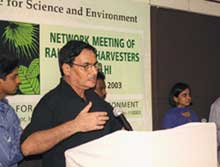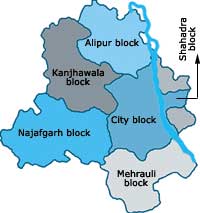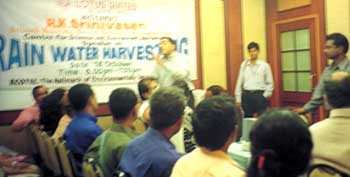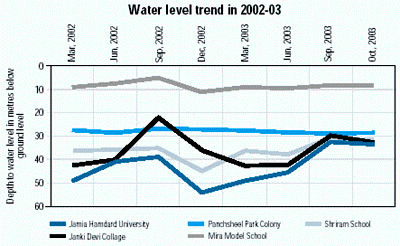
CSE’s Jal Swaraj campaign is about empowering civil society to manage its
own water. By reviving — with appropriate adaptation and integration of modern
systems — the traditional technology of rainwater harvesting. While the genesis of
the campaign is in rural India, sustained by innovative local practitioners, the campaign
also explores the tremendous potential of this system in the urban arena. Its urban
strategy is based on two principles: that local people must play a leading role in
conserving and managing water; and that they must be provided authentic information and
technical know-how to take this movement forward.
CSE campaigners have been working
on both these fronts, with considerable success.
 |
| Vijay
Saluja, superintendent, training, NDMC, at a CSE networking meeting in Delhi |
Training policy
makers
The rains have been abundant in most parts
of the country this year. Predictably, state governments have been on an overdrive, coming
up with policies and legislations — the key mantra being "exploring the
potential of rainwater harvesting (RWH)". Municipal corporations in several metros
have announced stringent norms and strict deadlines for installing structures in all
buildings — both public and private. Interestingly, CSE engineers were invited by
almost all civic bodies to hold training workshops to prepare their engineers, plumbers
and masons to tackle the growing demand from citizens for technical know-how on
RWH.
Delhi
The state government has been extremely
prompt in coming up with various policy measures — notifications, by-laws, financial
incentives — concerning RWH. Not all of them have yielded results. Lack of a proper
enforcement machinery and indifferent monitoring have, in fact, evoked criticisms from
experts. CSE has been keeping a vigil. It recently organised a network meeting, which
provided a platform for all RWH practitioners in the city, to share ideas, innovations and
concerns.
 |
Groundwater Prospect Map of Delhi
CSE’s www.rainwaterharvesting.org website presents this clickable map of the
city, that provides answers to some vital questions. It tells a reader who is concerned
about the city’s falling water table what the exact water level in his or her area
is. It goes further than that. It provides all the information that a person would require
to set up a rainwater harvesting structure. Soil profile, geological features, rainfall
pattern, quality of water—all these details can now be accessed by anyone who visits
this site. |
Hearteningly, members
from all government agencies, Delhi Jal Board (DJB), New Delhi Municipal Corporation
(NDMC), and Municipal Corporation of Delhi (MCD) attended the event and interacted with
the citizens. A joint action plan was drawn up, envisaging a proactive people-government
collaboration.
 |
| A rainwater harvesting workshop in Progress in Mumbai |
Uttar Pradesh
Kanpur may lie in the Indo-Gangetic plains,
yet its cup of water woes is overflowing. The city’s groundwater table has been
falling at an alarming rate in the past couple of years, and a recent State Groundwater
Department survey report reveals high level of chromium in the water due to unregulated
discharge of effluents from leather factories. The Kanpur Development Authority (KDA) is
convinced that the only sustainable solution lies in practicing and popularising RWH.
Anita Bhatnagar Jain, the enterprising vice chairperson of KDA, initiated a workshop and
CSE was invited to set the ball rolling. Similar programmes were then organised in others
cities such as Luknow, Meerut and Ghaziabad.
Andhra Pradesh
The Chandrababu Naidu government had set
tough targets for its officials this summer. With towns and cities reeling under a severe
water crisis, the authorities could not afford to let a single drop of rain go waste. As
the preparations began on a war footing, CSE engineers were invited to conduct a series of
training workshops in six municipalities — Hyderabad, Kurnool, Tirupathi,
Vishakhapatnam, Guntur and Warangal.
Tihar:
Sweeping the bastions
It was certainly one of CSE’s most challenging
assignments — teaching the residents of India’s largest prison the basics of
RWH. CSE was invited by jail authorities to hold a training programme in Tihar in
September 2003. The two harvesting structures, built within the premises in 2002 under
CSE’s technical guidance, have yielded rich dividends—pulling up the groundwater
table by two meters after the first bout of showers this year. The residents, especially
those familiar with masonry work, are keen to learn more. And the administrators are eager
to capitalise on this. They have decided to set up RWH harvesting structures covering the
entire jail complex, spread over 400 acres. The construction work will be conducted by the
residents, with support from CSE. The workshop, attended by 53 prisoners, signaled the
launch of this unique project. |
Maharashtra
The concept of RWH is just gaining ground in
Mumbai, and the BrihanMumbai Municipal Corporation (BMC) has been quick to respond. It has
come up with a legislation which not only promotes RWH but also makes recycling of
wastewater mandatory in all public buildings. It used CSE’s expertise to train a
group of professionals that will play a crucial role in this process — the
Brihanmumbai Licensed Plumbers Association. CSE also addressed an event that was jointly
organised by BMC and USAEP.
Tamil Nadu
The Jayalalitha government stirred a
hornet’s nest when it issued an ordinance announcing that all buildings within the
purview of the state municipal authority would have to set up RWH structures within a
month. The municipality — not equipped to deal with the situation — failed to
provide adequate technical or infrastructural support to the harried citizens. But CSE
believes that the CM’s move may infuse some life into the 1994 Chennai groundwater
legislation — that has till now done little to check the alarming drop in the
city’s groundwater table. The government’s real challenge will now be in
ensuring that the citizens are provided access to reliable data on the technology of RWH.
Stabilising
groundwater levels
Results from CSE’s model projects in Delhi
Designed by CSE staff, maintained by the people, this chain of model sites in Delhi is
used to demonstrate the impact of rainwater harvesting on the quality and quantity of
groundwater. CSE monitors the water levels throughout the year. |

|
In one such move, the
Bharat Sanchar Nigam Limited (BSNL), Tamil Nadu Zone, organised a seminar on RWH for civil
engineers. CSE held a technical session, focussing on maintenance issue.
|





